Understanding Grief: Kubler-Ross and Bowlby's Models and Stages
VerifiedAdded on 2020/06/05
|9
|3167
|41
Essay
AI Summary
This essay delves into the psychological processes of grief, examining two prominent models: Kubler-Ross's five stages of dying and John Bowlby's four stages of grieving. The essay begins by introducing the inevitability of loss and the emotional attachments that make bereavement so impactful. It then meticulously outlines Kubler-Ross's stages—denial, anger, bargaining, depression, and acceptance—providing detailed explanations of how individuals experience each stage. Following this, the essay explores Bowlby's attachment theory and its application to grief, presenting his four stages: shock and numbness, yearning and searching, despair and disorganization, and reorganization and recovery. The essay also includes recommendations on how to help people cope with bereavement, acknowledging the profound emotional and psychological impact of loss and offering insights into supporting those experiencing grief.
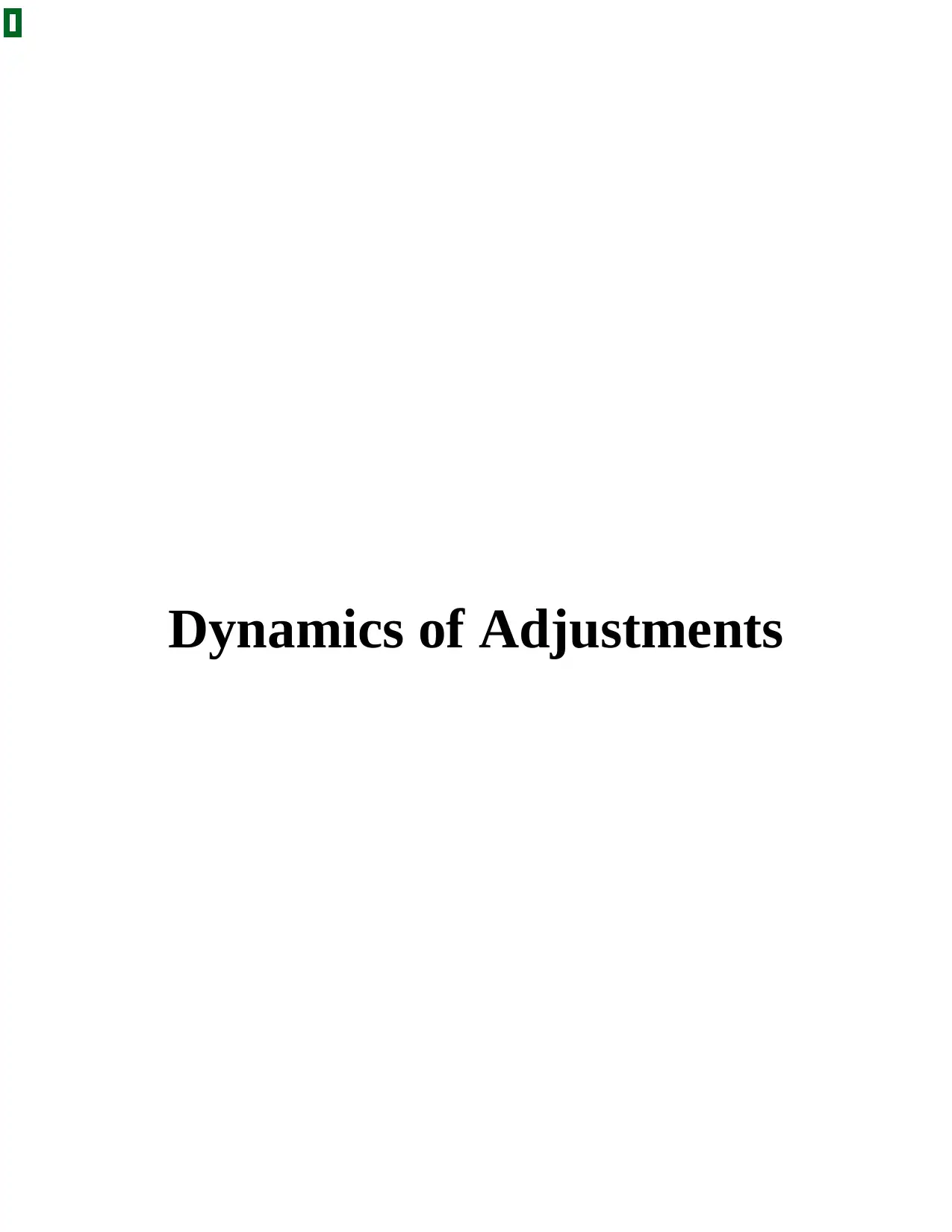
Dynamics of Adjustments
Paraphrase This Document
Need a fresh take? Get an instant paraphrase of this document with our AI Paraphraser
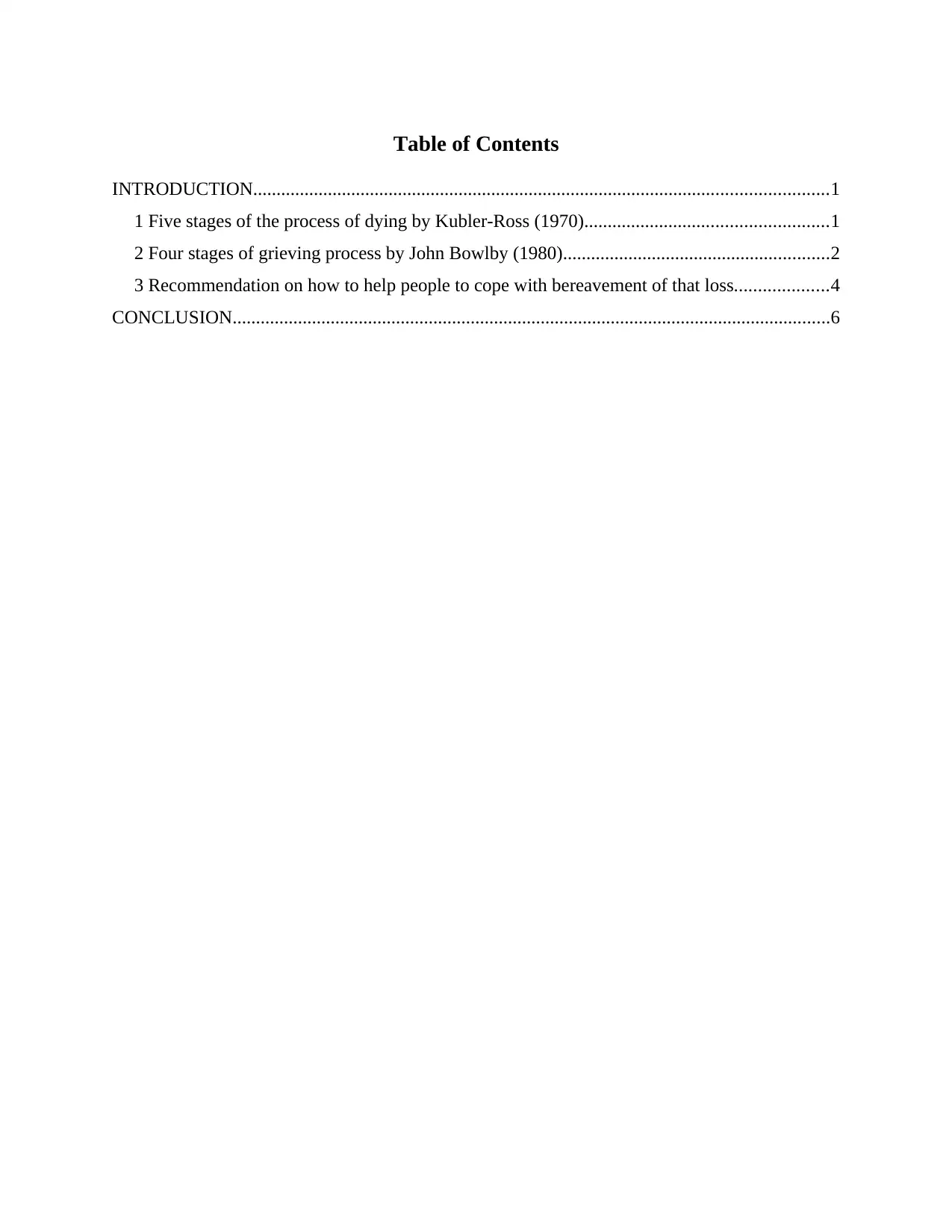
Table of Contents
INTRODUCTION...........................................................................................................................1
1 Five stages of the process of dying by Kubler-Ross (1970)....................................................1
2 Four stages of grieving process by John Bowlby (1980).........................................................2
3 Recommendation on how to help people to cope with bereavement of that loss....................4
CONCLUSION................................................................................................................................6
INTRODUCTION...........................................................................................................................1
1 Five stages of the process of dying by Kubler-Ross (1970)....................................................1
2 Four stages of grieving process by John Bowlby (1980).........................................................2
3 Recommendation on how to help people to cope with bereavement of that loss....................4
CONCLUSION................................................................................................................................6
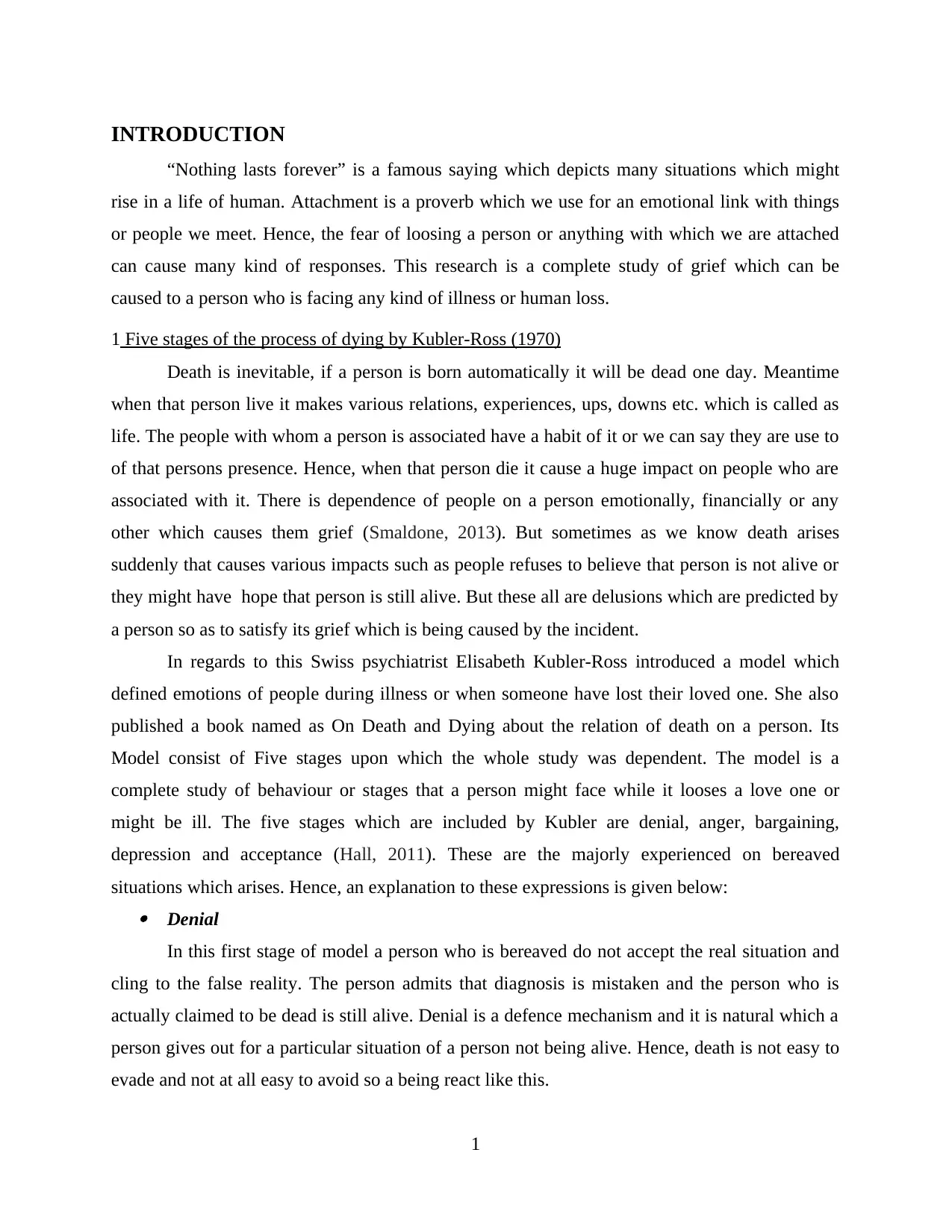
INTRODUCTION
“Nothing lasts forever” is a famous saying which depicts many situations which might
rise in a life of human. Attachment is a proverb which we use for an emotional link with things
or people we meet. Hence, the fear of loosing a person or anything with which we are attached
can cause many kind of responses. This research is a complete study of grief which can be
caused to a person who is facing any kind of illness or human loss.
1 Five stages of the process of dying by Kubler-Ross (1970)
Death is inevitable, if a person is born automatically it will be dead one day. Meantime
when that person live it makes various relations, experiences, ups, downs etc. which is called as
life. The people with whom a person is associated have a habit of it or we can say they are use to
of that persons presence. Hence, when that person die it cause a huge impact on people who are
associated with it. There is dependence of people on a person emotionally, financially or any
other which causes them grief (Smaldone, 2013). But sometimes as we know death arises
suddenly that causes various impacts such as people refuses to believe that person is not alive or
they might have hope that person is still alive. But these all are delusions which are predicted by
a person so as to satisfy its grief which is being caused by the incident.
In regards to this Swiss psychiatrist Elisabeth Kubler-Ross introduced a model which
defined emotions of people during illness or when someone have lost their loved one. She also
published a book named as On Death and Dying about the relation of death on a person. Its
Model consist of Five stages upon which the whole study was dependent. The model is a
complete study of behaviour or stages that a person might face while it looses a love one or
might be ill. The five stages which are included by Kubler are denial, anger, bargaining,
depression and acceptance (Hall, 2011). These are the majorly experienced on bereaved
situations which arises. Hence, an explanation to these expressions is given below: Denial
In this first stage of model a person who is bereaved do not accept the real situation and
cling to the false reality. The person admits that diagnosis is mistaken and the person who is
actually claimed to be dead is still alive. Denial is a defence mechanism and it is natural which a
person gives out for a particular situation of a person not being alive. Hence, death is not easy to
evade and not at all easy to avoid so a being react like this.
1
“Nothing lasts forever” is a famous saying which depicts many situations which might
rise in a life of human. Attachment is a proverb which we use for an emotional link with things
or people we meet. Hence, the fear of loosing a person or anything with which we are attached
can cause many kind of responses. This research is a complete study of grief which can be
caused to a person who is facing any kind of illness or human loss.
1 Five stages of the process of dying by Kubler-Ross (1970)
Death is inevitable, if a person is born automatically it will be dead one day. Meantime
when that person live it makes various relations, experiences, ups, downs etc. which is called as
life. The people with whom a person is associated have a habit of it or we can say they are use to
of that persons presence. Hence, when that person die it cause a huge impact on people who are
associated with it. There is dependence of people on a person emotionally, financially or any
other which causes them grief (Smaldone, 2013). But sometimes as we know death arises
suddenly that causes various impacts such as people refuses to believe that person is not alive or
they might have hope that person is still alive. But these all are delusions which are predicted by
a person so as to satisfy its grief which is being caused by the incident.
In regards to this Swiss psychiatrist Elisabeth Kubler-Ross introduced a model which
defined emotions of people during illness or when someone have lost their loved one. She also
published a book named as On Death and Dying about the relation of death on a person. Its
Model consist of Five stages upon which the whole study was dependent. The model is a
complete study of behaviour or stages that a person might face while it looses a love one or
might be ill. The five stages which are included by Kubler are denial, anger, bargaining,
depression and acceptance (Hall, 2011). These are the majorly experienced on bereaved
situations which arises. Hence, an explanation to these expressions is given below: Denial
In this first stage of model a person who is bereaved do not accept the real situation and
cling to the false reality. The person admits that diagnosis is mistaken and the person who is
actually claimed to be dead is still alive. Denial is a defence mechanism and it is natural which a
person gives out for a particular situation of a person not being alive. Hence, death is not easy to
evade and not at all easy to avoid so a being react like this.
1
⊘ This is a preview!⊘
Do you want full access?
Subscribe today to unlock all pages.

Trusted by 1+ million students worldwide
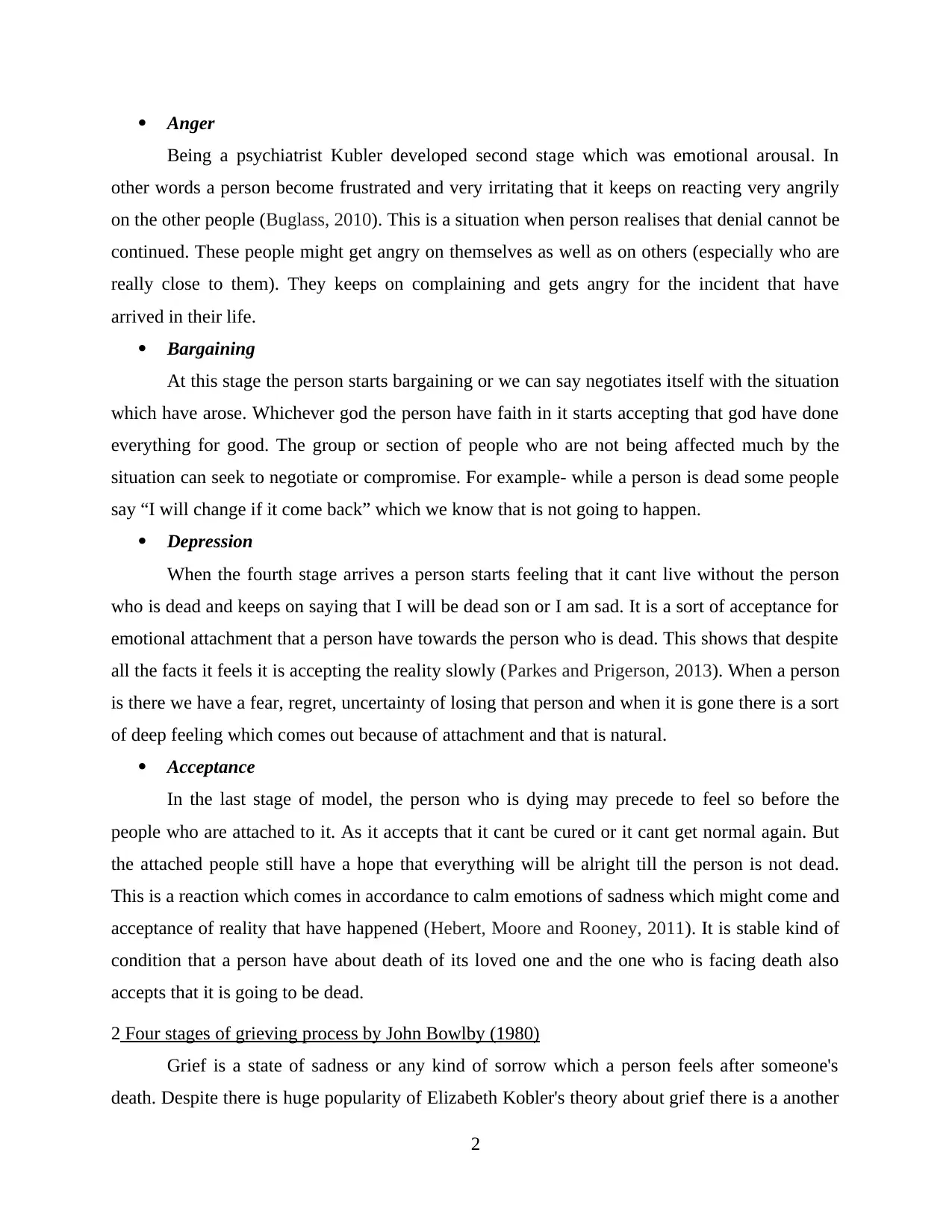
Anger
Being a psychiatrist Kubler developed second stage which was emotional arousal. In
other words a person become frustrated and very irritating that it keeps on reacting very angrily
on the other people (Buglass, 2010). This is a situation when person realises that denial cannot be
continued. These people might get angry on themselves as well as on others (especially who are
really close to them). They keeps on complaining and gets angry for the incident that have
arrived in their life.
Bargaining
At this stage the person starts bargaining or we can say negotiates itself with the situation
which have arose. Whichever god the person have faith in it starts accepting that god have done
everything for good. The group or section of people who are not being affected much by the
situation can seek to negotiate or compromise. For example- while a person is dead some people
say “I will change if it come back” which we know that is not going to happen.
Depression
When the fourth stage arrives a person starts feeling that it cant live without the person
who is dead and keeps on saying that I will be dead son or I am sad. It is a sort of acceptance for
emotional attachment that a person have towards the person who is dead. This shows that despite
all the facts it feels it is accepting the reality slowly (Parkes and Prigerson, 2013). When a person
is there we have a fear, regret, uncertainty of losing that person and when it is gone there is a sort
of deep feeling which comes out because of attachment and that is natural.
Acceptance
In the last stage of model, the person who is dying may precede to feel so before the
people who are attached to it. As it accepts that it cant be cured or it cant get normal again. But
the attached people still have a hope that everything will be alright till the person is not dead.
This is a reaction which comes in accordance to calm emotions of sadness which might come and
acceptance of reality that have happened (Hebert, Moore and Rooney, 2011). It is stable kind of
condition that a person have about death of its loved one and the one who is facing death also
accepts that it is going to be dead.
2 Four stages of grieving process by John Bowlby (1980)
Grief is a state of sadness or any kind of sorrow which a person feels after someone's
death. Despite there is huge popularity of Elizabeth Kobler's theory about grief there is a another
2
Being a psychiatrist Kubler developed second stage which was emotional arousal. In
other words a person become frustrated and very irritating that it keeps on reacting very angrily
on the other people (Buglass, 2010). This is a situation when person realises that denial cannot be
continued. These people might get angry on themselves as well as on others (especially who are
really close to them). They keeps on complaining and gets angry for the incident that have
arrived in their life.
Bargaining
At this stage the person starts bargaining or we can say negotiates itself with the situation
which have arose. Whichever god the person have faith in it starts accepting that god have done
everything for good. The group or section of people who are not being affected much by the
situation can seek to negotiate or compromise. For example- while a person is dead some people
say “I will change if it come back” which we know that is not going to happen.
Depression
When the fourth stage arrives a person starts feeling that it cant live without the person
who is dead and keeps on saying that I will be dead son or I am sad. It is a sort of acceptance for
emotional attachment that a person have towards the person who is dead. This shows that despite
all the facts it feels it is accepting the reality slowly (Parkes and Prigerson, 2013). When a person
is there we have a fear, regret, uncertainty of losing that person and when it is gone there is a sort
of deep feeling which comes out because of attachment and that is natural.
Acceptance
In the last stage of model, the person who is dying may precede to feel so before the
people who are attached to it. As it accepts that it cant be cured or it cant get normal again. But
the attached people still have a hope that everything will be alright till the person is not dead.
This is a reaction which comes in accordance to calm emotions of sadness which might come and
acceptance of reality that have happened (Hebert, Moore and Rooney, 2011). It is stable kind of
condition that a person have about death of its loved one and the one who is facing death also
accepts that it is going to be dead.
2 Four stages of grieving process by John Bowlby (1980)
Grief is a state of sadness or any kind of sorrow which a person feels after someone's
death. Despite there is huge popularity of Elizabeth Kobler's theory about grief there is a another
2
Paraphrase This Document
Need a fresh take? Get an instant paraphrase of this document with our AI Paraphraser
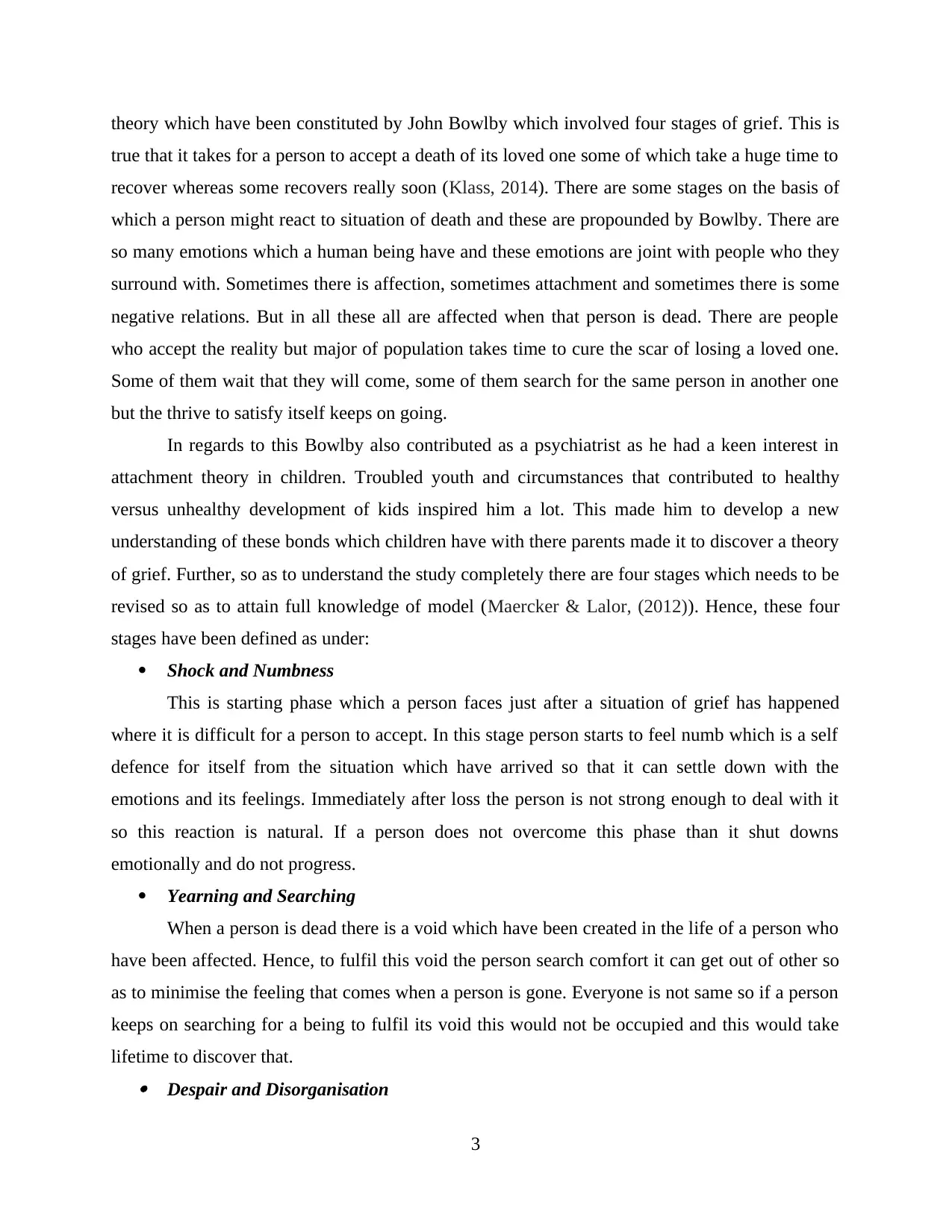
theory which have been constituted by John Bowlby which involved four stages of grief. This is
true that it takes for a person to accept a death of its loved one some of which take a huge time to
recover whereas some recovers really soon (Klass, 2014). There are some stages on the basis of
which a person might react to situation of death and these are propounded by Bowlby. There are
so many emotions which a human being have and these emotions are joint with people who they
surround with. Sometimes there is affection, sometimes attachment and sometimes there is some
negative relations. But in all these all are affected when that person is dead. There are people
who accept the reality but major of population takes time to cure the scar of losing a loved one.
Some of them wait that they will come, some of them search for the same person in another one
but the thrive to satisfy itself keeps on going.
In regards to this Bowlby also contributed as a psychiatrist as he had a keen interest in
attachment theory in children. Troubled youth and circumstances that contributed to healthy
versus unhealthy development of kids inspired him a lot. This made him to develop a new
understanding of these bonds which children have with there parents made it to discover a theory
of grief. Further, so as to understand the study completely there are four stages which needs to be
revised so as to attain full knowledge of model (Maercker & Lalor, (2012)). Hence, these four
stages have been defined as under:
Shock and Numbness
This is starting phase which a person faces just after a situation of grief has happened
where it is difficult for a person to accept. In this stage person starts to feel numb which is a self
defence for itself from the situation which have arrived so that it can settle down with the
emotions and its feelings. Immediately after loss the person is not strong enough to deal with it
so this reaction is natural. If a person does not overcome this phase than it shut downs
emotionally and do not progress.
Yearning and Searching
When a person is dead there is a void which have been created in the life of a person who
have been affected. Hence, to fulfil this void the person search comfort it can get out of other so
as to minimise the feeling that comes when a person is gone. Everyone is not same so if a person
keeps on searching for a being to fulfil its void this would not be occupied and this would take
lifetime to discover that. Despair and Disorganisation
3
true that it takes for a person to accept a death of its loved one some of which take a huge time to
recover whereas some recovers really soon (Klass, 2014). There are some stages on the basis of
which a person might react to situation of death and these are propounded by Bowlby. There are
so many emotions which a human being have and these emotions are joint with people who they
surround with. Sometimes there is affection, sometimes attachment and sometimes there is some
negative relations. But in all these all are affected when that person is dead. There are people
who accept the reality but major of population takes time to cure the scar of losing a loved one.
Some of them wait that they will come, some of them search for the same person in another one
but the thrive to satisfy itself keeps on going.
In regards to this Bowlby also contributed as a psychiatrist as he had a keen interest in
attachment theory in children. Troubled youth and circumstances that contributed to healthy
versus unhealthy development of kids inspired him a lot. This made him to develop a new
understanding of these bonds which children have with there parents made it to discover a theory
of grief. Further, so as to understand the study completely there are four stages which needs to be
revised so as to attain full knowledge of model (Maercker & Lalor, (2012)). Hence, these four
stages have been defined as under:
Shock and Numbness
This is starting phase which a person faces just after a situation of grief has happened
where it is difficult for a person to accept. In this stage person starts to feel numb which is a self
defence for itself from the situation which have arrived so that it can settle down with the
emotions and its feelings. Immediately after loss the person is not strong enough to deal with it
so this reaction is natural. If a person does not overcome this phase than it shut downs
emotionally and do not progress.
Yearning and Searching
When a person is dead there is a void which have been created in the life of a person who
have been affected. Hence, to fulfil this void the person search comfort it can get out of other so
as to minimise the feeling that comes when a person is gone. Everyone is not same so if a person
keeps on searching for a being to fulfil its void this would not be occupied and this would take
lifetime to discover that. Despair and Disorganisation
3
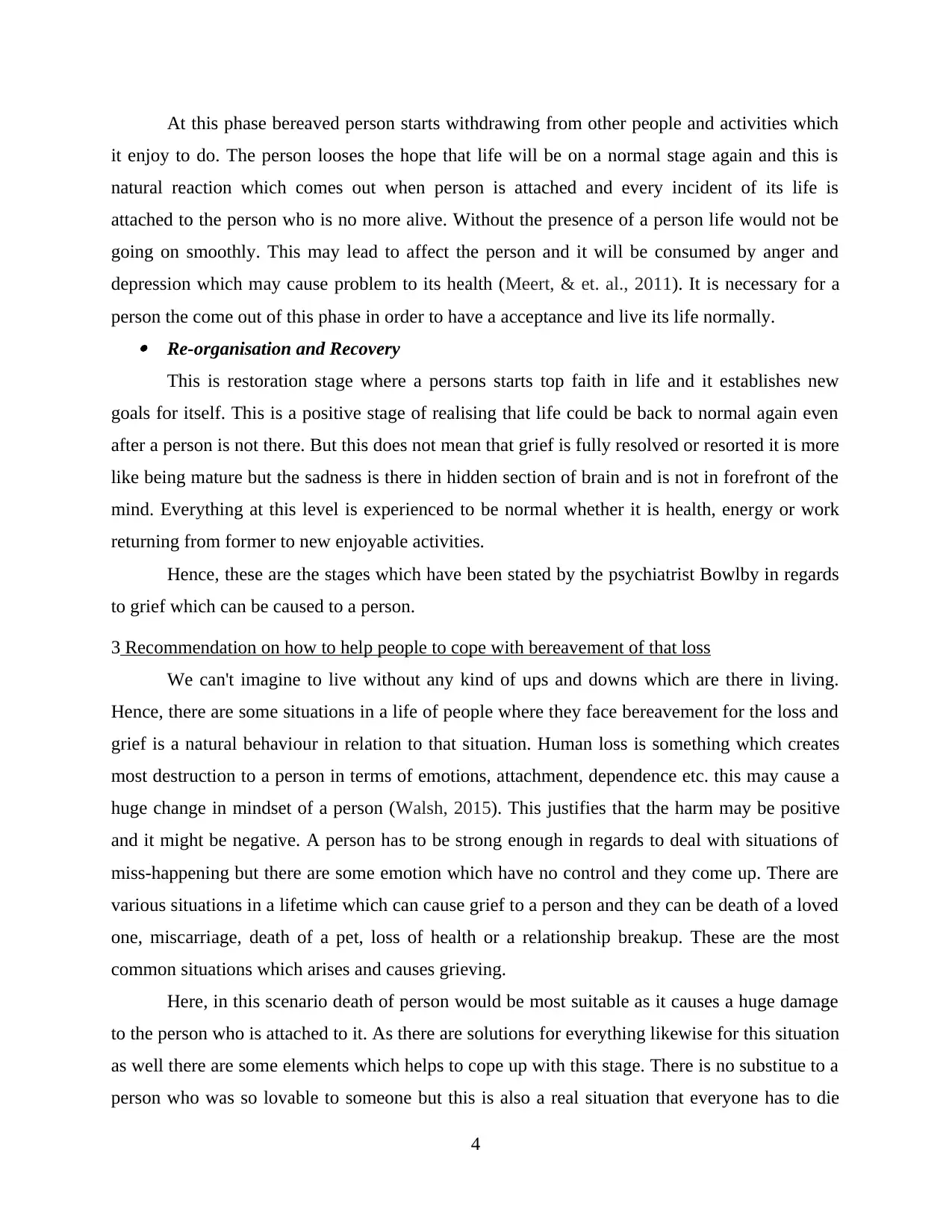
At this phase bereaved person starts withdrawing from other people and activities which
it enjoy to do. The person looses the hope that life will be on a normal stage again and this is
natural reaction which comes out when person is attached and every incident of its life is
attached to the person who is no more alive. Without the presence of a person life would not be
going on smoothly. This may lead to affect the person and it will be consumed by anger and
depression which may cause problem to its health (Meert, & et. al., 2011). It is necessary for a
person the come out of this phase in order to have a acceptance and live its life normally. Re-organisation and Recovery
This is restoration stage where a persons starts top faith in life and it establishes new
goals for itself. This is a positive stage of realising that life could be back to normal again even
after a person is not there. But this does not mean that grief is fully resolved or resorted it is more
like being mature but the sadness is there in hidden section of brain and is not in forefront of the
mind. Everything at this level is experienced to be normal whether it is health, energy or work
returning from former to new enjoyable activities.
Hence, these are the stages which have been stated by the psychiatrist Bowlby in regards
to grief which can be caused to a person.
3 Recommendation on how to help people to cope with bereavement of that loss
We can't imagine to live without any kind of ups and downs which are there in living.
Hence, there are some situations in a life of people where they face bereavement for the loss and
grief is a natural behaviour in relation to that situation. Human loss is something which creates
most destruction to a person in terms of emotions, attachment, dependence etc. this may cause a
huge change in mindset of a person (Walsh, 2015). This justifies that the harm may be positive
and it might be negative. A person has to be strong enough in regards to deal with situations of
miss-happening but there are some emotion which have no control and they come up. There are
various situations in a lifetime which can cause grief to a person and they can be death of a loved
one, miscarriage, death of a pet, loss of health or a relationship breakup. These are the most
common situations which arises and causes grieving.
Here, in this scenario death of person would be most suitable as it causes a huge damage
to the person who is attached to it. As there are solutions for everything likewise for this situation
as well there are some elements which helps to cope up with this stage. There is no substitue to a
person who was so lovable to someone but this is also a real situation that everyone has to die
4
it enjoy to do. The person looses the hope that life will be on a normal stage again and this is
natural reaction which comes out when person is attached and every incident of its life is
attached to the person who is no more alive. Without the presence of a person life would not be
going on smoothly. This may lead to affect the person and it will be consumed by anger and
depression which may cause problem to its health (Meert, & et. al., 2011). It is necessary for a
person the come out of this phase in order to have a acceptance and live its life normally. Re-organisation and Recovery
This is restoration stage where a persons starts top faith in life and it establishes new
goals for itself. This is a positive stage of realising that life could be back to normal again even
after a person is not there. But this does not mean that grief is fully resolved or resorted it is more
like being mature but the sadness is there in hidden section of brain and is not in forefront of the
mind. Everything at this level is experienced to be normal whether it is health, energy or work
returning from former to new enjoyable activities.
Hence, these are the stages which have been stated by the psychiatrist Bowlby in regards
to grief which can be caused to a person.
3 Recommendation on how to help people to cope with bereavement of that loss
We can't imagine to live without any kind of ups and downs which are there in living.
Hence, there are some situations in a life of people where they face bereavement for the loss and
grief is a natural behaviour in relation to that situation. Human loss is something which creates
most destruction to a person in terms of emotions, attachment, dependence etc. this may cause a
huge change in mindset of a person (Walsh, 2015). This justifies that the harm may be positive
and it might be negative. A person has to be strong enough in regards to deal with situations of
miss-happening but there are some emotion which have no control and they come up. There are
various situations in a lifetime which can cause grief to a person and they can be death of a loved
one, miscarriage, death of a pet, loss of health or a relationship breakup. These are the most
common situations which arises and causes grieving.
Here, in this scenario death of person would be most suitable as it causes a huge damage
to the person who is attached to it. As there are solutions for everything likewise for this situation
as well there are some elements which helps to cope up with this stage. There is no substitue to a
person who was so lovable to someone but this is also a real situation that everyone has to die
4
⊘ This is a preview!⊘
Do you want full access?
Subscribe today to unlock all pages.

Trusted by 1+ million students worldwide
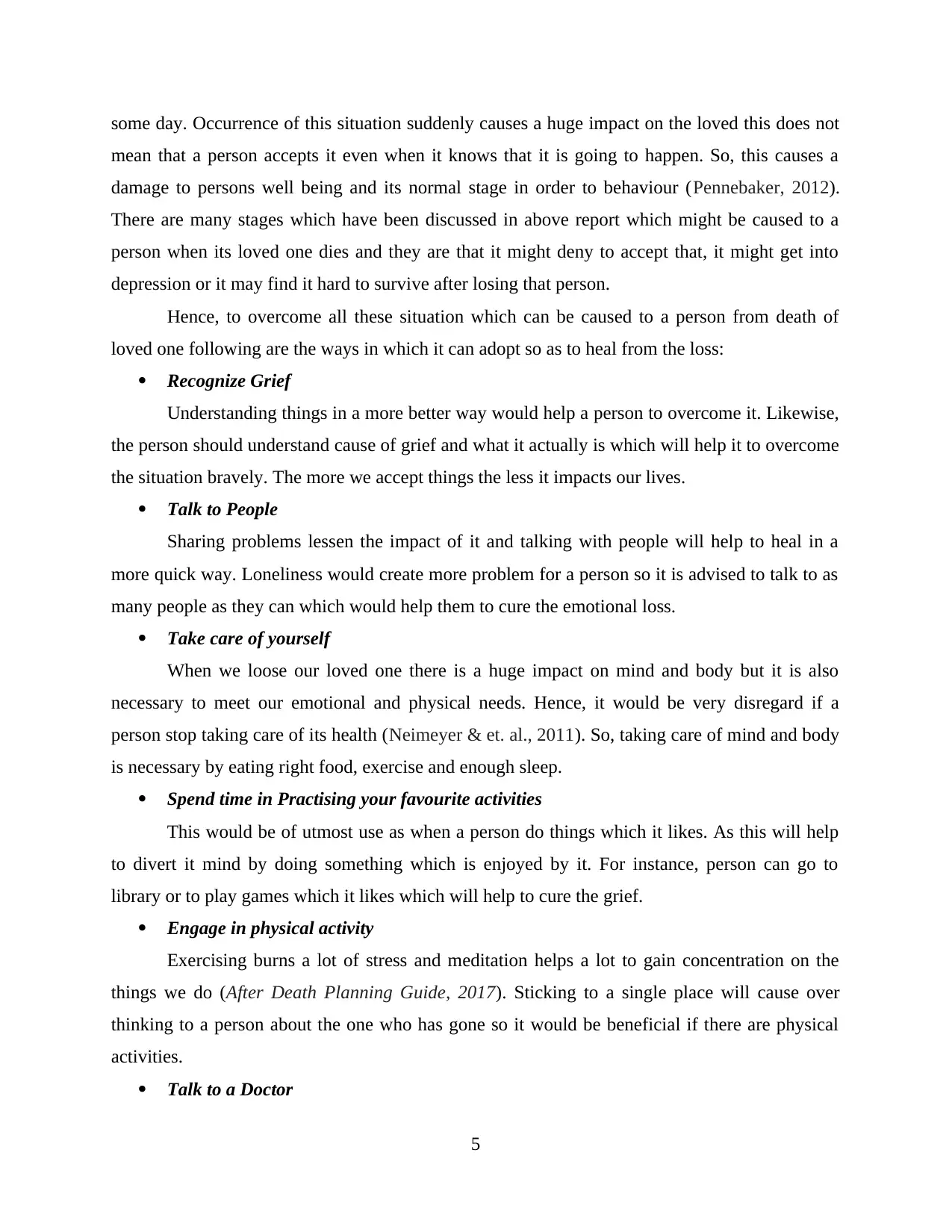
some day. Occurrence of this situation suddenly causes a huge impact on the loved this does not
mean that a person accepts it even when it knows that it is going to happen. So, this causes a
damage to persons well being and its normal stage in order to behaviour (Pennebaker, 2012).
There are many stages which have been discussed in above report which might be caused to a
person when its loved one dies and they are that it might deny to accept that, it might get into
depression or it may find it hard to survive after losing that person.
Hence, to overcome all these situation which can be caused to a person from death of
loved one following are the ways in which it can adopt so as to heal from the loss:
Recognize Grief
Understanding things in a more better way would help a person to overcome it. Likewise,
the person should understand cause of grief and what it actually is which will help it to overcome
the situation bravely. The more we accept things the less it impacts our lives.
Talk to People
Sharing problems lessen the impact of it and talking with people will help to heal in a
more quick way. Loneliness would create more problem for a person so it is advised to talk to as
many people as they can which would help them to cure the emotional loss.
Take care of yourself
When we loose our loved one there is a huge impact on mind and body but it is also
necessary to meet our emotional and physical needs. Hence, it would be very disregard if a
person stop taking care of its health (Neimeyer & et. al., 2011). So, taking care of mind and body
is necessary by eating right food, exercise and enough sleep.
Spend time in Practising your favourite activities
This would be of utmost use as when a person do things which it likes. As this will help
to divert it mind by doing something which is enjoyed by it. For instance, person can go to
library or to play games which it likes which will help to cure the grief.
Engage in physical activity
Exercising burns a lot of stress and meditation helps a lot to gain concentration on the
things we do (After Death Planning Guide, 2017). Sticking to a single place will cause over
thinking to a person about the one who has gone so it would be beneficial if there are physical
activities.
Talk to a Doctor
5
mean that a person accepts it even when it knows that it is going to happen. So, this causes a
damage to persons well being and its normal stage in order to behaviour (Pennebaker, 2012).
There are many stages which have been discussed in above report which might be caused to a
person when its loved one dies and they are that it might deny to accept that, it might get into
depression or it may find it hard to survive after losing that person.
Hence, to overcome all these situation which can be caused to a person from death of
loved one following are the ways in which it can adopt so as to heal from the loss:
Recognize Grief
Understanding things in a more better way would help a person to overcome it. Likewise,
the person should understand cause of grief and what it actually is which will help it to overcome
the situation bravely. The more we accept things the less it impacts our lives.
Talk to People
Sharing problems lessen the impact of it and talking with people will help to heal in a
more quick way. Loneliness would create more problem for a person so it is advised to talk to as
many people as they can which would help them to cure the emotional loss.
Take care of yourself
When we loose our loved one there is a huge impact on mind and body but it is also
necessary to meet our emotional and physical needs. Hence, it would be very disregard if a
person stop taking care of its health (Neimeyer & et. al., 2011). So, taking care of mind and body
is necessary by eating right food, exercise and enough sleep.
Spend time in Practising your favourite activities
This would be of utmost use as when a person do things which it likes. As this will help
to divert it mind by doing something which is enjoyed by it. For instance, person can go to
library or to play games which it likes which will help to cure the grief.
Engage in physical activity
Exercising burns a lot of stress and meditation helps a lot to gain concentration on the
things we do (After Death Planning Guide, 2017). Sticking to a single place will cause over
thinking to a person about the one who has gone so it would be beneficial if there are physical
activities.
Talk to a Doctor
5
Paraphrase This Document
Need a fresh take? Get an instant paraphrase of this document with our AI Paraphraser
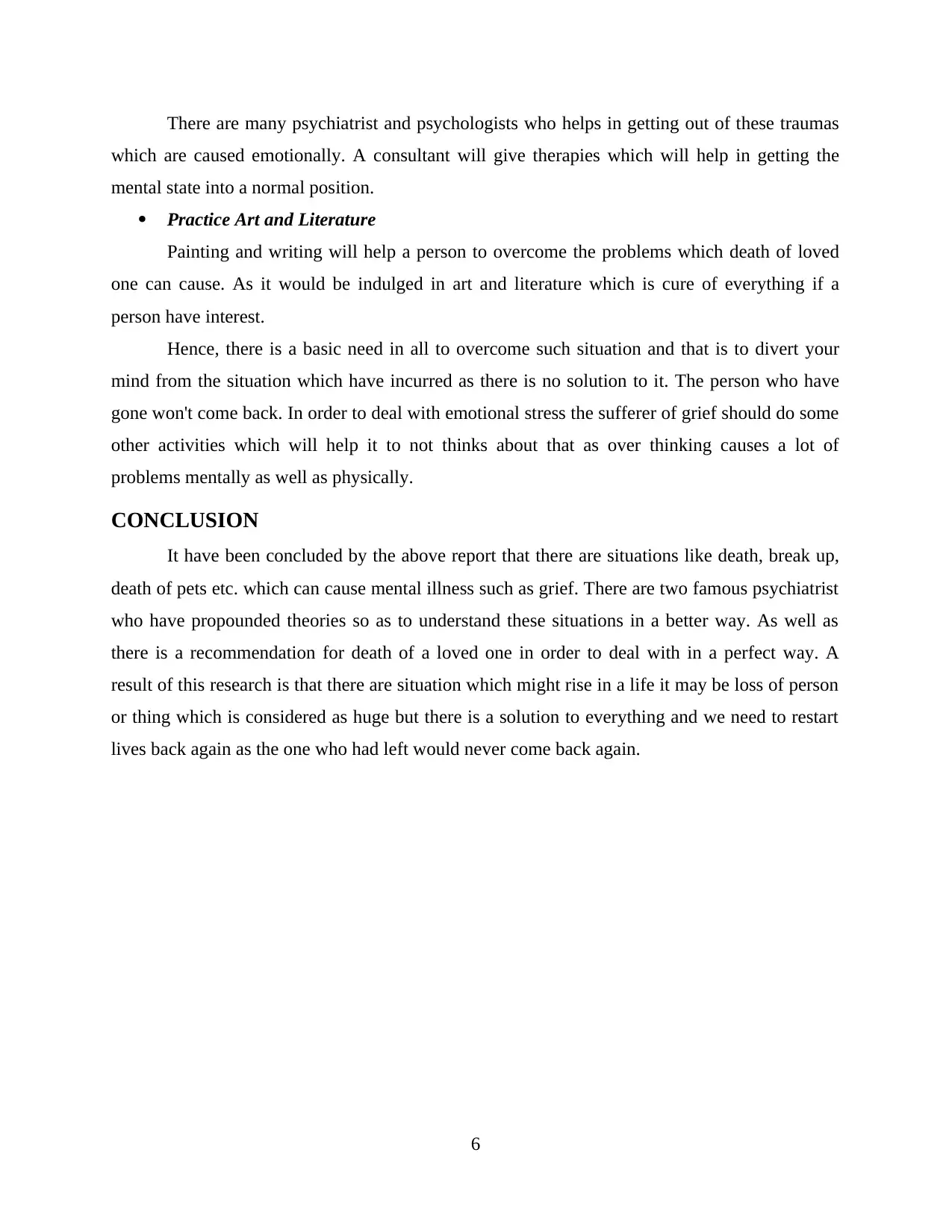
There are many psychiatrist and psychologists who helps in getting out of these traumas
which are caused emotionally. A consultant will give therapies which will help in getting the
mental state into a normal position.
Practice Art and Literature
Painting and writing will help a person to overcome the problems which death of loved
one can cause. As it would be indulged in art and literature which is cure of everything if a
person have interest.
Hence, there is a basic need in all to overcome such situation and that is to divert your
mind from the situation which have incurred as there is no solution to it. The person who have
gone won't come back. In order to deal with emotional stress the sufferer of grief should do some
other activities which will help it to not thinks about that as over thinking causes a lot of
problems mentally as well as physically.
CONCLUSION
It have been concluded by the above report that there are situations like death, break up,
death of pets etc. which can cause mental illness such as grief. There are two famous psychiatrist
who have propounded theories so as to understand these situations in a better way. As well as
there is a recommendation for death of a loved one in order to deal with in a perfect way. A
result of this research is that there are situation which might rise in a life it may be loss of person
or thing which is considered as huge but there is a solution to everything and we need to restart
lives back again as the one who had left would never come back again.
6
which are caused emotionally. A consultant will give therapies which will help in getting the
mental state into a normal position.
Practice Art and Literature
Painting and writing will help a person to overcome the problems which death of loved
one can cause. As it would be indulged in art and literature which is cure of everything if a
person have interest.
Hence, there is a basic need in all to overcome such situation and that is to divert your
mind from the situation which have incurred as there is no solution to it. The person who have
gone won't come back. In order to deal with emotional stress the sufferer of grief should do some
other activities which will help it to not thinks about that as over thinking causes a lot of
problems mentally as well as physically.
CONCLUSION
It have been concluded by the above report that there are situations like death, break up,
death of pets etc. which can cause mental illness such as grief. There are two famous psychiatrist
who have propounded theories so as to understand these situations in a better way. As well as
there is a recommendation for death of a loved one in order to deal with in a perfect way. A
result of this research is that there are situation which might rise in a life it may be loss of person
or thing which is considered as huge but there is a solution to everything and we need to restart
lives back again as the one who had left would never come back again.
6
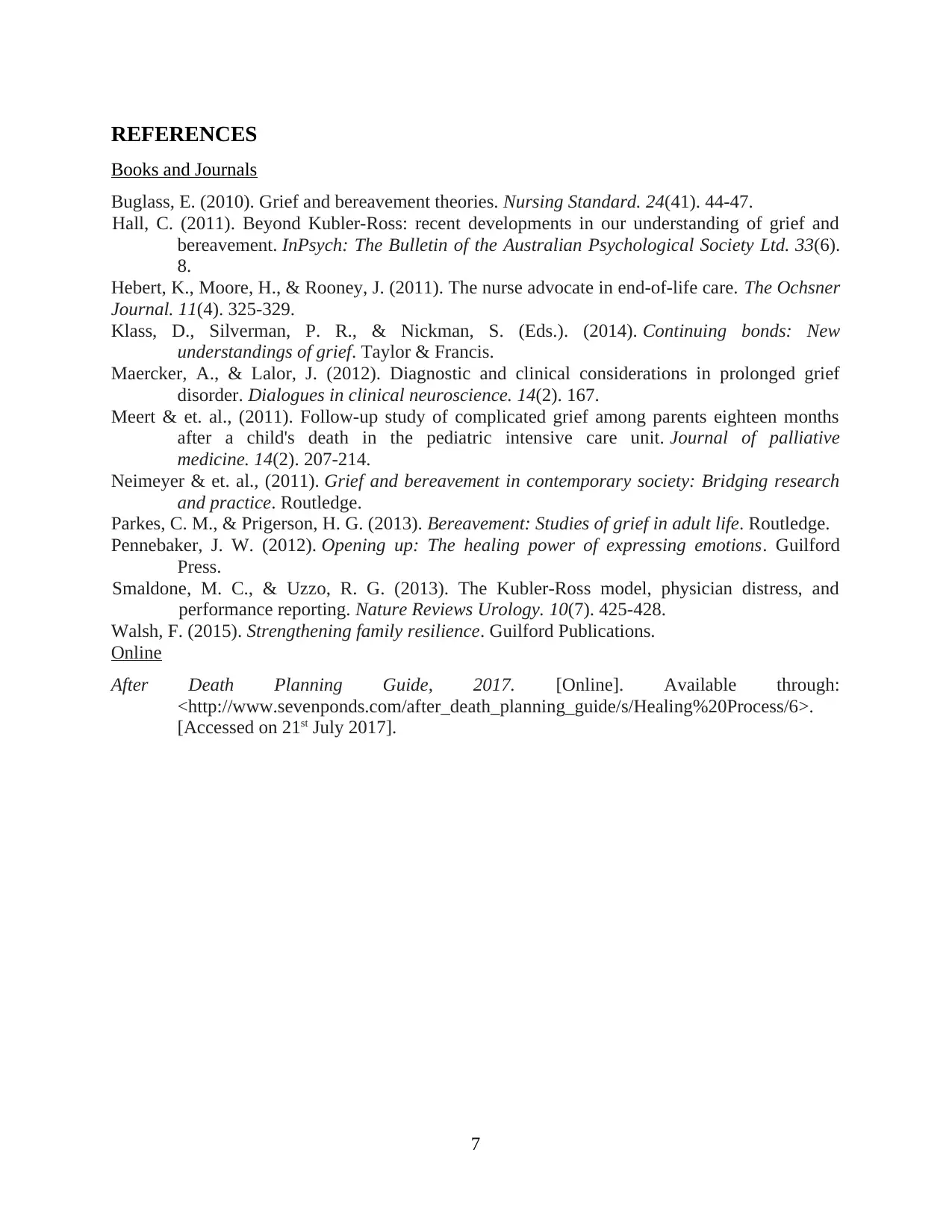
REFERENCES
Books and Journals
Buglass, E. (2010). Grief and bereavement theories. Nursing Standard. 24(41). 44-47.
Hall, C. (2011). Beyond Kubler-Ross: recent developments in our understanding of grief and
bereavement. InPsych: The Bulletin of the Australian Psychological Society Ltd. 33(6).
8.
Hebert, K., Moore, H., & Rooney, J. (2011). The nurse advocate in end-of-life care. The Ochsner
Journal. 11(4). 325-329.
Klass, D., Silverman, P. R., & Nickman, S. (Eds.). (2014). Continuing bonds: New
understandings of grief. Taylor & Francis.
Maercker, A., & Lalor, J. (2012). Diagnostic and clinical considerations in prolonged grief
disorder. Dialogues in clinical neuroscience. 14(2). 167.
Meert & et. al., (2011). Follow-up study of complicated grief among parents eighteen months
after a child's death in the pediatric intensive care unit. Journal of palliative
medicine. 14(2). 207-214.
Neimeyer & et. al., (2011). Grief and bereavement in contemporary society: Bridging research
and practice. Routledge.
Parkes, C. M., & Prigerson, H. G. (2013). Bereavement: Studies of grief in adult life. Routledge.
Pennebaker, J. W. (2012). Opening up: The healing power of expressing emotions. Guilford
Press.
Smaldone, M. C., & Uzzo, R. G. (2013). The Kubler-Ross model, physician distress, and
performance reporting. Nature Reviews Urology. 10(7). 425-428.
Walsh, F. (2015). Strengthening family resilience. Guilford Publications.
Online
After Death Planning Guide, 2017. [Online]. Available through:
<http://www.sevenponds.com/after_death_planning_guide/s/Healing%20Process/6>.
[Accessed on 21st July 2017].
7
Books and Journals
Buglass, E. (2010). Grief and bereavement theories. Nursing Standard. 24(41). 44-47.
Hall, C. (2011). Beyond Kubler-Ross: recent developments in our understanding of grief and
bereavement. InPsych: The Bulletin of the Australian Psychological Society Ltd. 33(6).
8.
Hebert, K., Moore, H., & Rooney, J. (2011). The nurse advocate in end-of-life care. The Ochsner
Journal. 11(4). 325-329.
Klass, D., Silverman, P. R., & Nickman, S. (Eds.). (2014). Continuing bonds: New
understandings of grief. Taylor & Francis.
Maercker, A., & Lalor, J. (2012). Diagnostic and clinical considerations in prolonged grief
disorder. Dialogues in clinical neuroscience. 14(2). 167.
Meert & et. al., (2011). Follow-up study of complicated grief among parents eighteen months
after a child's death in the pediatric intensive care unit. Journal of palliative
medicine. 14(2). 207-214.
Neimeyer & et. al., (2011). Grief and bereavement in contemporary society: Bridging research
and practice. Routledge.
Parkes, C. M., & Prigerson, H. G. (2013). Bereavement: Studies of grief in adult life. Routledge.
Pennebaker, J. W. (2012). Opening up: The healing power of expressing emotions. Guilford
Press.
Smaldone, M. C., & Uzzo, R. G. (2013). The Kubler-Ross model, physician distress, and
performance reporting. Nature Reviews Urology. 10(7). 425-428.
Walsh, F. (2015). Strengthening family resilience. Guilford Publications.
Online
After Death Planning Guide, 2017. [Online]. Available through:
<http://www.sevenponds.com/after_death_planning_guide/s/Healing%20Process/6>.
[Accessed on 21st July 2017].
7
⊘ This is a preview!⊘
Do you want full access?
Subscribe today to unlock all pages.

Trusted by 1+ million students worldwide
1 out of 9
Related Documents
Your All-in-One AI-Powered Toolkit for Academic Success.
+13062052269
info@desklib.com
Available 24*7 on WhatsApp / Email
![[object Object]](/_next/static/media/star-bottom.7253800d.svg)
Unlock your academic potential
Copyright © 2020–2025 A2Z Services. All Rights Reserved. Developed and managed by ZUCOL.





